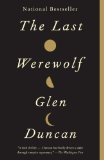Summary | Excerpt | Reading Guide | Reviews | Beyond the Book | Read-Alikes | Genres & Themes | Author Bio

This article relates to The Last Werewolf
From the 1941 classic film The Wolfman (see video clip below) to Michael Jackson's music video for "Thriller," from Harry Potter's Professor Remus Lupin to Jacob Black in Stephenie Meyer's Twilight series, the ancient symbol of the werewolf continues to play an active role in modern storytelling and carries a great deal of mythological meaning.
The term werewolf is most commonly believed to derive from the Old English wer (also were), meaning "man," and wulf, meaning "wolf" or "beast." The word lycanthrope, another term for werewolf, comes from the ancient Greek lykánthropos, meaning "wolf" (lükos) and "human" (ánthropos).
Though there are many variations on the werewolf story, these folkloric creatures are commonly recognized as humans who (either by curse or by infection) have the ability to transform into wolves or wolf-like creatures at the onset of a full moon. Often ruled by animal instincts, they kill and feast on human flesh.
 Some of the earliest recorded stories of werewolves come from Greek mythology; for example, in The Histories, Herodotus (c.484 B.C. - c.425 B.C.) describes a tribe of people called the Neuri who morph into wolves for a few days every year. According to Ovid's Metamorphoses, Lycaon, the King of Arcadia, tried to trick Zeus into eating raw meat (to see if he really was a god). Zeus, of course, discovered the deception before consuming the meat and, as a punishment, transformed Lycaon into a wolf.
Some of the earliest recorded stories of werewolves come from Greek mythology; for example, in The Histories, Herodotus (c.484 B.C. - c.425 B.C.) describes a tribe of people called the Neuri who morph into wolves for a few days every year. According to Ovid's Metamorphoses, Lycaon, the King of Arcadia, tried to trick Zeus into eating raw meat (to see if he really was a god). Zeus, of course, discovered the deception before consuming the meat and, as a punishment, transformed Lycaon into a wolf.
Over time and throughout different cultures, the symbol of the werewolf has taken on many meanings and variations (for example, the loup-garou in France, the oik in Albania, the volkodlak in Slovenia, and the reverential, shamanistic Kurtadam in Turkey) and has informed famous literary characters such as the Big Bad Wolf in Aesop's Fables and Grimm's Fairy Tales.
Often associated with untamed energies, trickery or deceit, and the underbelly of primal human instincts, the werewolf can be interpreted as the struggle between (and the integration of) both "good" and "evil" within a human being - the inescapable and uncontrollable nature of our raw emotional urges, whether sexual, violent, or destructive.
And perhaps the expression of these taboo emotions, and our fascination with that struggle, is what makes the werewolf such an interesting and culturally relevant symbol thousands of years in the making.
For a peek at Michael Jackson's "transformation" in the Thriller video (directed by John Landis, who, incidentally, also directed the 1981 film An American Werewolf in London), click on the video below.
For information on other gothic ghouls, check out our "beyond the book" info on vampires.
Filed under Cultural Curiosities
![]() This "beyond the book article" relates to The Last Werewolf. It originally ran in July 2011 and has been updated for the
April 2012 paperback edition.
Go to magazine.
This "beyond the book article" relates to The Last Werewolf. It originally ran in July 2011 and has been updated for the
April 2012 paperback edition.
Go to magazine.






Your guide toexceptional books
BookBrowse seeks out and recommends the best in contemporary fiction and nonfiction—books that not only engage and entertain but also deepen our understanding of ourselves and the world around us.